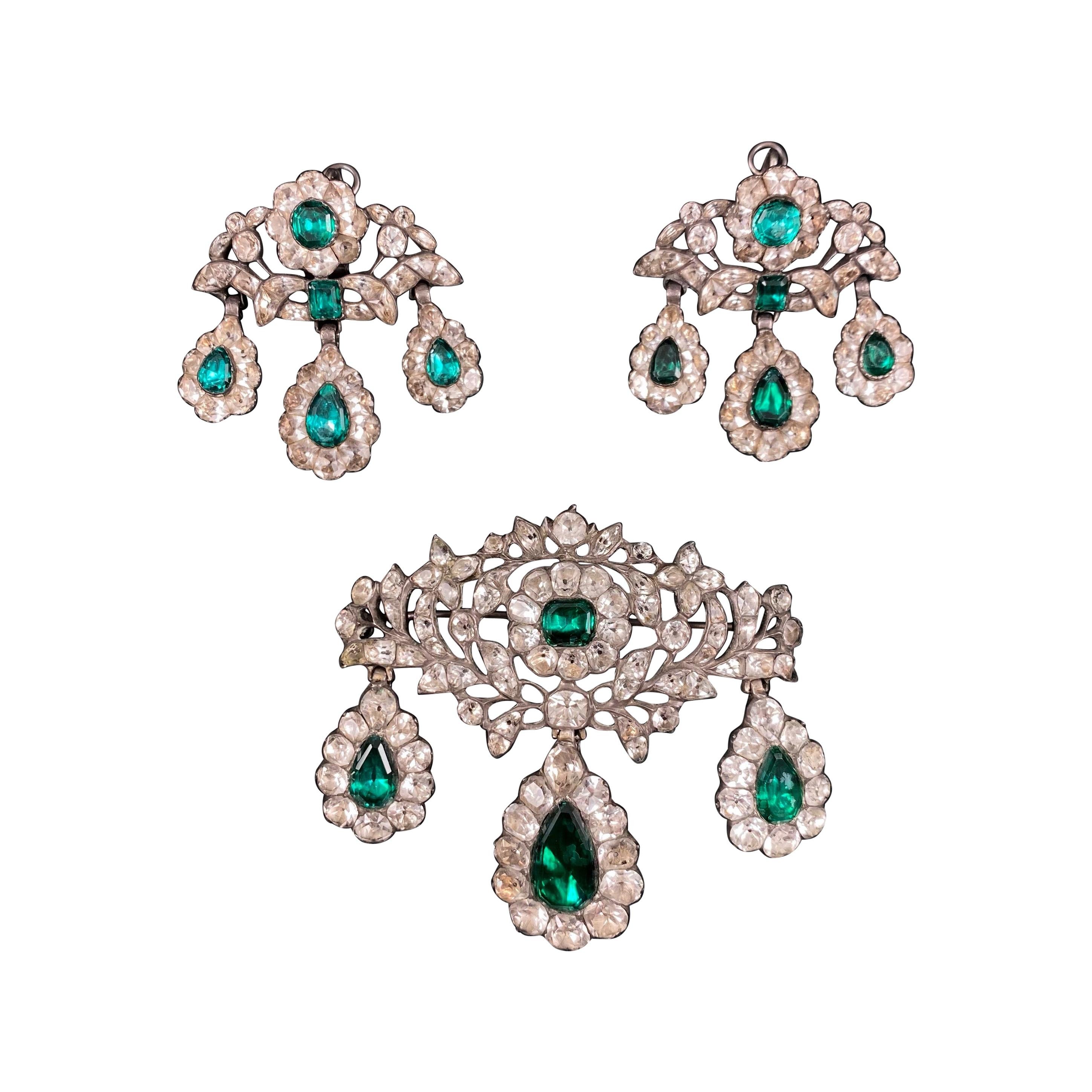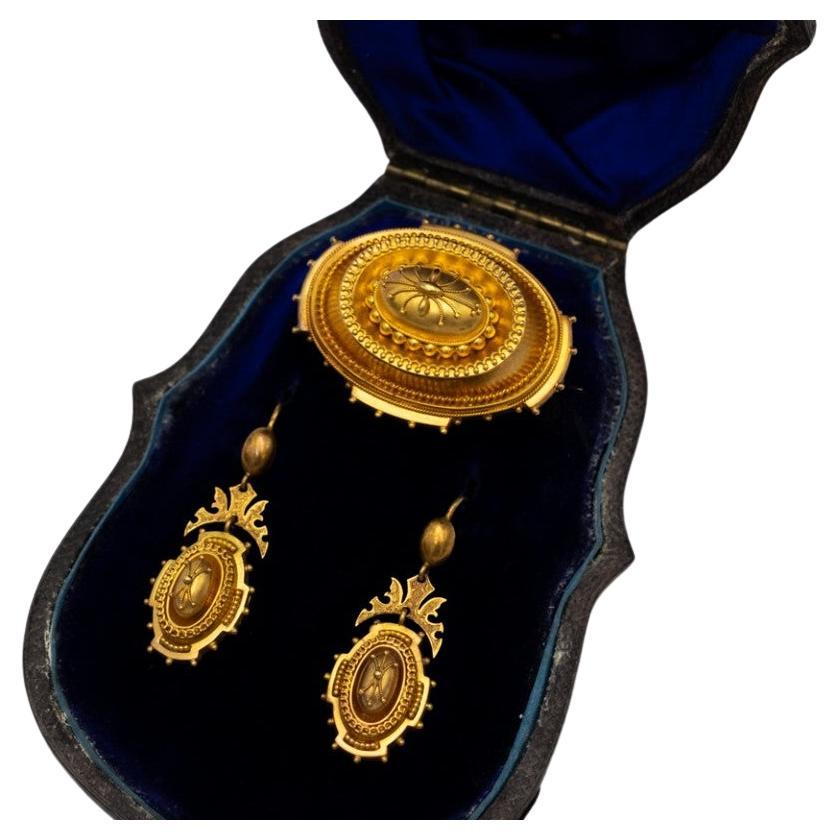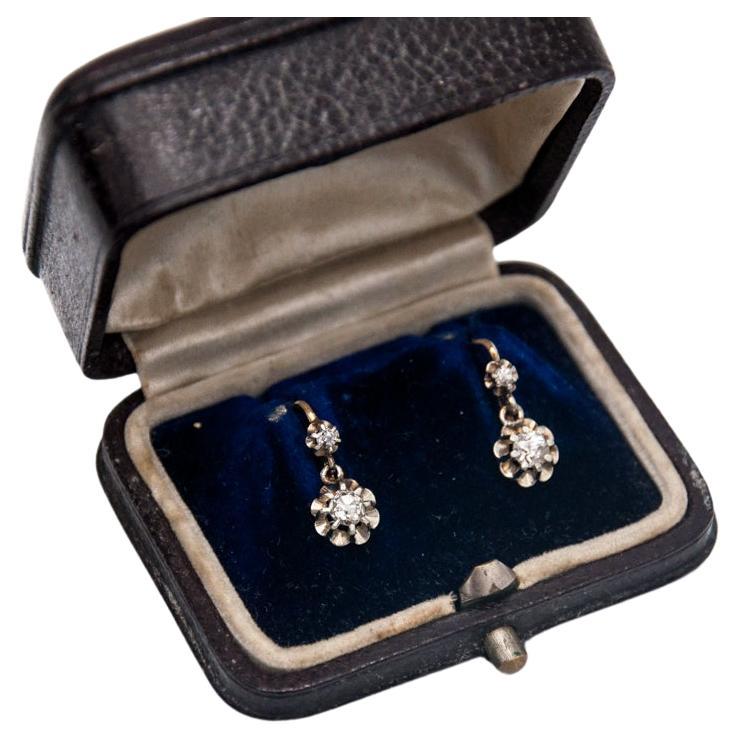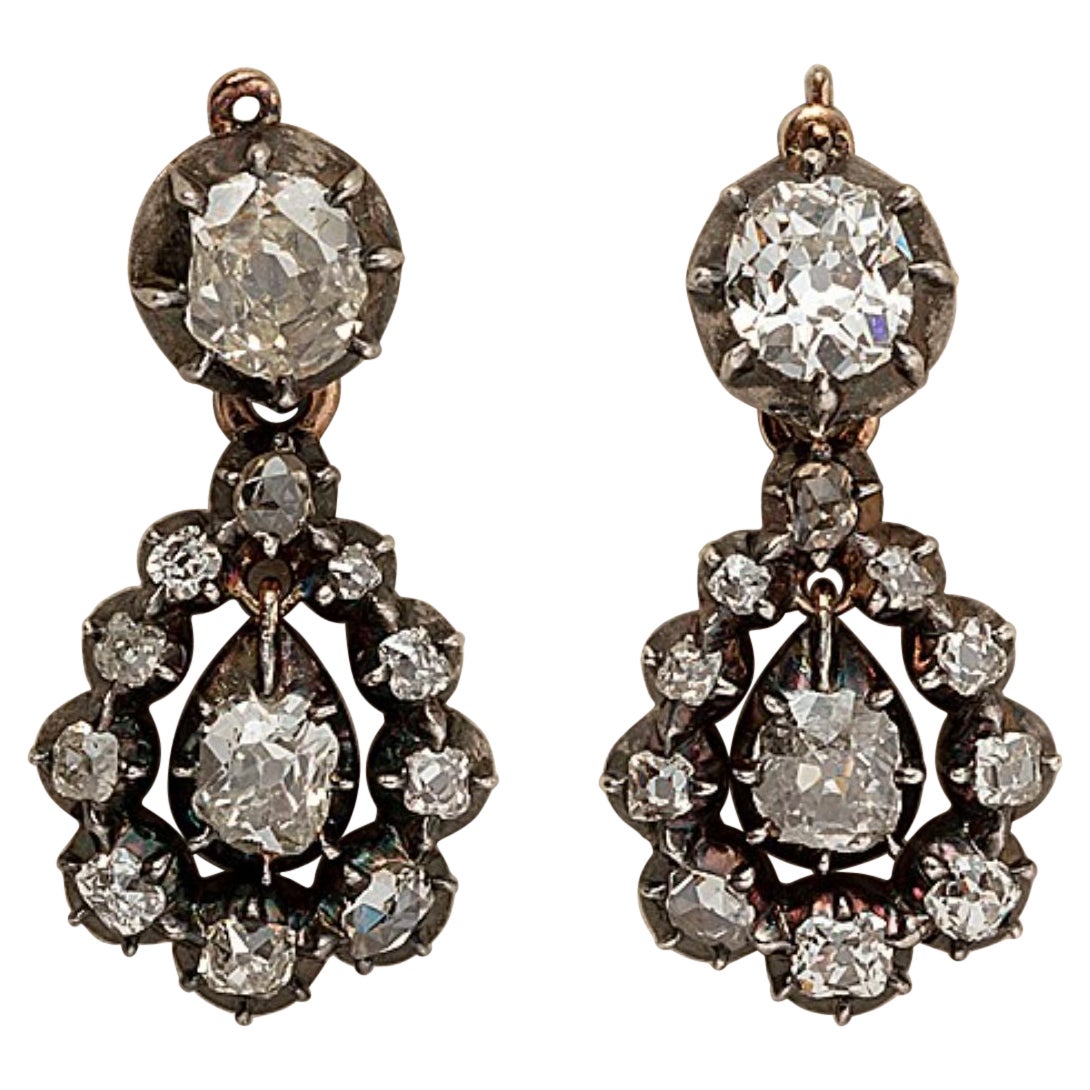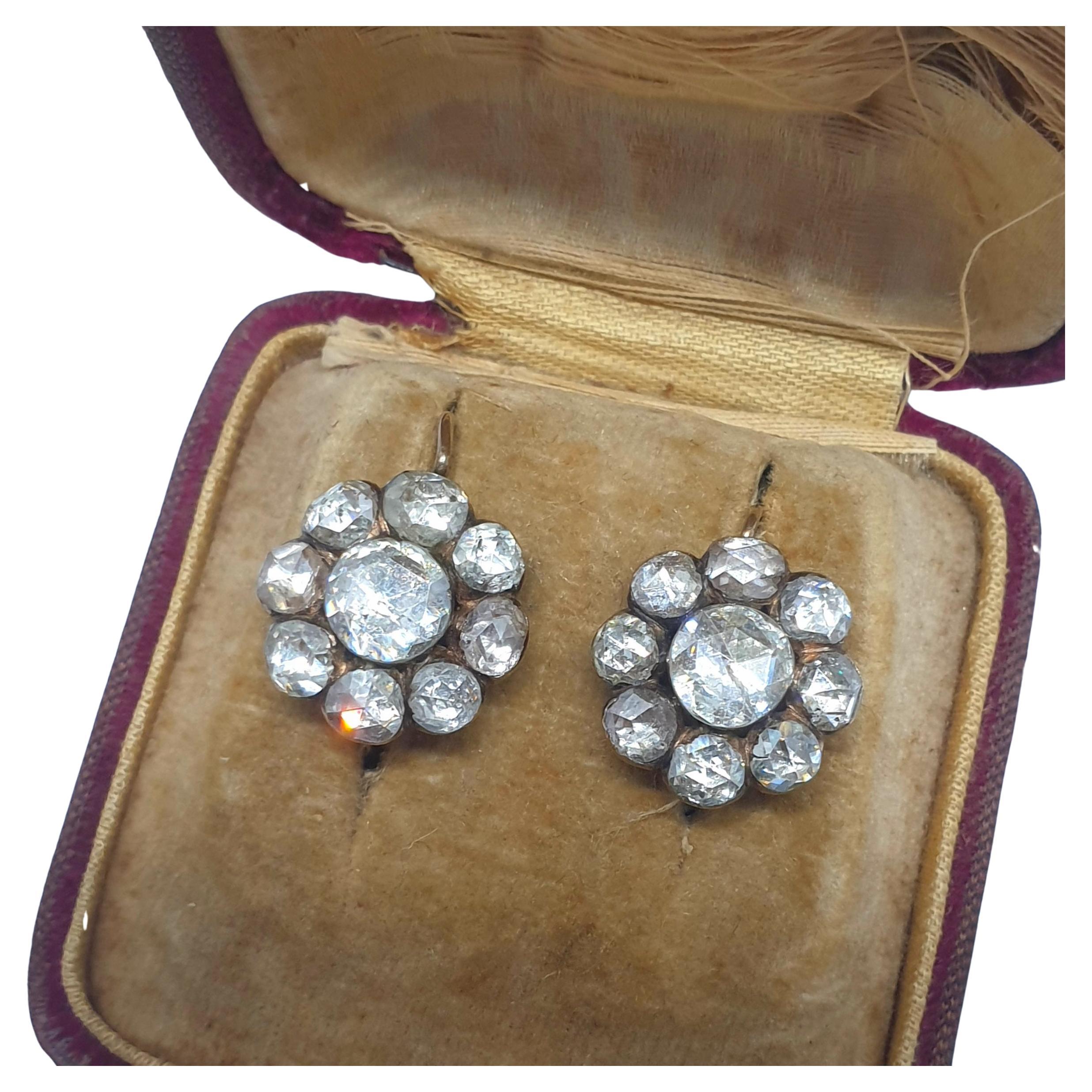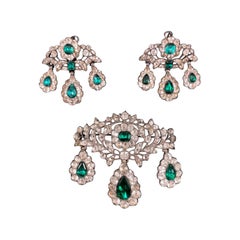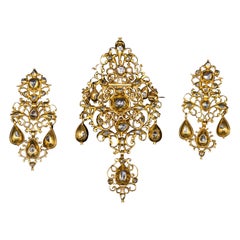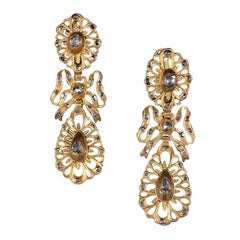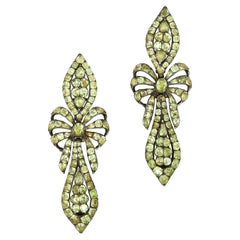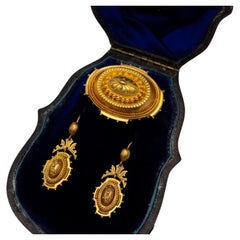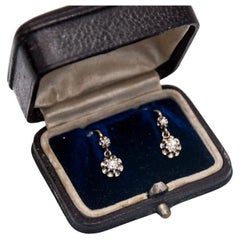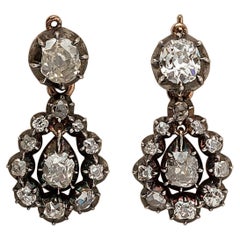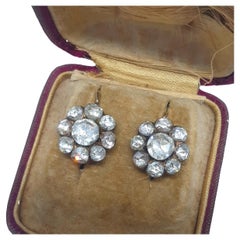Items Similar to Antique 18th Century Minas Novas Earrings Pendant/Brooch Girandole Portuguese
Video Loading
Want more images or videos?
Request additional images or videos from the seller
1 of 22
Antique 18th Century Minas Novas Earrings Pendant/Brooch Girandole Portuguese
$53,165.37
£39,850.74
€45,000
CA$73,040.18
A$81,542.49
CHF 42,727.04
MX$998,160.08
NOK 542,633.80
SEK 511,634.78
DKK 342,556.42
About the Item
Museum-quality rare and important antique 18th century Minas Novas rock crystal quartz girandole pendant and earrings demi-parure mounted in closed-back silver, Portuguese, circa 1770, fitted in an antique case. From the second half of the eighteenth century, the pendant/brooch is set throughout with Minas Novas and composed by crossed foliate branches accented to the center and to the top with a flowerhead motif, suspending three articulated and graduated pear-shape Minas Novas cluster drops in the girandole fashion. The dangle earrings en suite also of a girandole design are composed of a similar foliate and floral surmount suspending three articulated pear-shape Minas Novas cluster drops, secured to reverse with lever-back hoop fittings consistent with the period. These jewels are embellished throughout with circular, oval pear, antique cushion, marquise and calibré cut colorless rock crystal quartz closed-set in foil-back silver. Genuine and original 18th century chrysolite jewels of this style and design are exceedingly rare and highly collectible. Most of these treasures now belong to museums and the most important private collections, out of reach to the general public.
Tested as silver, not marked; Lisbon control mark “old man’s head” for antique jewelry. Dimensions: 7.5 x 6.3cm (pendant); 5.1 x 3.8cm (each earring). Gross weight: 36.12g (pendant/brooch); 26.88g (earrings).
Of all the styles of eighteenth-century designs, the girandole was probably the most desirable or night wear. Its style was classic: a central bow or floral-shaped cluster ornament from which were suspended three pear-shaped pendants, the middle pendant usually larger than the two flanking it. Dating back to the 17th century, when beautiful examples were made in rose cut diamonds, the girandole remained fashionable for over a hundred years, possibly because the proportion was particularly flattering to the female face. During the 18th century, girandoles were produced all over Europe in every conceivable material, but some of the most fabulous were crafted in Portugal of topaz, “chrysolite” chrysoberyl and “Minas Novas” (colorless topaz, colorless quartz and sometimes by association, paste).
The fashion for wearing girandole earrings and brooches of girandole form was to continue right up to the 19th century to be gradually superseded by less flamboyant and more practical styles in the 1840s and 1850s. When girandoles finally went out of fashion, many outstanding examples were broken up to be transformed or simply got damaged beyond repair. This should help appreciate the rarity of the present jewel being offered, which survived the test of time, fashion and wear.
Both Portugal and Spain had colonies in South America. Brazil was a treasure trove of precious stones, yielding huge quantities of diamonds, topaz, aquamarine and chrysoberyl gems, which were made into jewelry back in Portugal. These gemstones were pieced together and pave-set to create suites of swagged and beribboned necklaces and earrings in floral and bow motifs. In 1735, the mines of Minas Gerais in Brazil yielded a seam of imperial topaz with a slight pinkish hue. The colorful floral and bow jewelry of Portugal made great use of this delightful gemstone, sometimes mixing it with chrysoberyl, or aquamarine. Imperial topaz was always a costly gemstone and it was not always easy to find enough gemstones of perfectly matched colors to go together in a jewel. That is why it is common for these antique Iberian jewels to be set with a foil behind it, which would enhance the gems’ appearance and help color-match the stones to create the prettiest effect.
For similar or equivalent late 1700s Portuguese jewels, see d'Orey, Leonor, "Five Centuries of Jewellery", permanent exhibition of the National Museum of Ancient Art, Lisbon, Zwemmer Publishers Limited, 1995, pages 70, 72, 73, 76, 77, 80, 84-87 and 92-94.
For similar or equivalent late 1700s Portuguese jewels, see “Oceanos - Ourivesaria Luso-Brasileira do Ciclo do Ouro e dos Diamantes N.43", Lisbon, Comissão Nacional para as Comemorações dos Descobrimentos Portugueses, 2000, pages 12, 17, 19, 22, 27, 28, 47, 50 and 181.
For similar or equivalent late 1700s Portuguese jewels, see de Vasconcelos e Sousa, D. Gonçalo, "Reais Jóias no Norte de Portugal", permanent exhibition of Palácio da Bolsa, Oporto, Artes Gráficas – Lello & Irmão, November 1995, ALGUMAS PEÇAS PRESENTES NA EXPOSIÇÃO section.
For similar or equivalent Georgian Iberian (Portuguese and Spanish), English and French jewels, see Dawnes, Ginny Redington and Collings, Olivia, "Georgian Jewellery", ACC Art Books, Suffolk, 2018, pages 16, 22, 72, 73, 83, 85, 93, 106-108, 110, 111 and 141.
For similar or equivalent late 1700s Portuguese jewels, see Scarisbrick, Diana, “The S. J. Phillips Collection of Jewels of Portugal”, London, Sotheby’s, S.J.Phillips, 2017, pages 16, 36-38, 46-49, 56, 57, 63, 65, 68, 69 and 71.
For similar late 1700s Georgian girandole Portuguese jewels, see Dawnes, Ginny Redington and Collings, Olivia, "Georgian Jewellery", ACC Art Books, Suffolk, 2018, pages 108 and 110.
This item is in good condition, with marks and scratches consistent with general age and wear. Antique, period and vintage pieces, both signed and unsigned, are being offered as worn. Unless otherwise stated, all weights and quality factors have been graded as mounting permitted and using classic gemology and standard gemological equipment and might slightly differ from the assessments provided by other gemologists. Assessments related to period of manufacture or geographic origin of gemstones are expert opinions and may differ from the assessments provided by other professionals. Colors in the pictures/videos might slightly differ from the colors in real life. When certificated stones are being offered, the certificate or report will be mentioned. For additional information or clarification, please get in touch and our in-house team of expert GIA Graduate Gemologists and Registered Appraisers/Valuers will be happy to help.
Upon request, every item sold by Espadim 1985 will be accompanied by a complimentary valuation, which you can use for insurance, authenticity and reference and safekeeping purposes; this will contain a detailed description, technical information and photographic records of the item.
- Metal:
- Stone:
- Stone Cut:
- Weight:63 g
- Dimensions:Width: 2.49 in (63 mm)Length: 2.96 in (75 mm)
- Style:
- Place of Origin:
- Period:1770-1779
- Date of Manufacture:Circa 1770
- Condition:Wear consistent with age and use.
- Seller Location:Lisbon, PT
- Reference Number:Seller: 502/21E1stDibs: LU2150214693002
About the Seller
5.0
Recognized Seller
These prestigious sellers are industry leaders and represent the highest echelon for item quality and design.
Established in 1985
1stDibs seller since 2020
28 sales on 1stDibs
Typical response time: <1 hour
- ShippingRetrieving quote...Shipping from: Lisbon, Portugal
- Return Policy
Authenticity Guarantee
In the unlikely event there’s an issue with an item’s authenticity, contact us within 1 year for a full refund. DetailsMoney-Back Guarantee
If your item is not as described, is damaged in transit, or does not arrive, contact us within 7 days for a full refund. Details24-Hour Cancellation
You have a 24-hour grace period in which to reconsider your purchase, with no questions asked.Vetted Professional Sellers
Our world-class sellers must adhere to strict standards for service and quality, maintaining the integrity of our listings.Price-Match Guarantee
If you find that a seller listed the same item for a lower price elsewhere, we’ll match it.Trusted Global Delivery
Our best-in-class carrier network provides specialized shipping options worldwide, including custom delivery.More From This Seller
View AllAntique 18th Century Minas Novas Rock Crystal Topaz Girandole Earrings Brooch
Located in Lisbon, PT
Antique 18th century “Minas Novas” rock crystal, colorless topaz and simulated-emerald doblet girandole earrings and pendant/brooch demi-parure, Portuguese...
Category
Antique 1770s Portuguese Georgian Dangle Earrings
Materials
Crystal, Quartz, Rock Crystal, Topaz, Silver
Antique 17th/18th Century Sequilé Diamond Demi-Parure Yellow Gold Portuguese
Located in Lisbon, PT
Museum-quality antique late 17th/early 18th century diamond and yellow gold Baroque “sequilé” earrings and pendant/brooch demi-parure, Portuguese, with hallmarks from the period and ...
Category
Antique Early 18th Century Portuguese Georgian Dangle Earrings
Materials
Diamond, Gold, Yellow Gold
Antique 18th Century Diamond Princess Pendeloque Drop Earrings Gold Portuguese
Located in Lisbon, PT
Museum-quality 18th century rose-cut diamond ‘princess style’ pendeloque pendant earrings in rose gold, Portugal. Of elongated and slightly exaggerated outline typical of the period,...
Category
Antique 18th Century Portuguese Georgian Drop Earrings
Materials
Diamond, Gold, 18k Gold, Yellow Gold
Antique 18th Century Chrysolite Chrysoberyl Pendant Earrings Portuguese 1770s
Located in Lisbon, PT
Museum quality antique 18th century chrysolite chrysoberyl pendeloque pendant earrings, Portugal, circa 1770. Each earring of an openwork design with a navette shape cluster top suspending a ribbon-tied bow terminal from which hangs an elongated drop-shaped cluster, pave- and collet-set throughout with circular, marquise, cushion and calibre cut yellowish-green chrysoberyl stones close-set in silver. These earrings are secured to reverse with a lever-back fitting consistent with Portuguese jewels of this period.
Later Porto assay mark “old man’s head” (used 1884-1984) for antique artefacts. Dimensions: 7.9 x 2.6 cm. Gross weight: 37.26g.
For a similar pair of Portuguese Georgian chrysoberyl earrings...
Category
Antique 1770s Portuguese Georgian Drop Earrings
Materials
Chrysoberyl, Silver
Antique 18th/19th Century Rose-Cut Diamonds Devant de Corsage Silver Portuguese
Located in Lisbon, PT
Antique Late 18th / 19th Century rose-cut diamond devant de corsage or stomacher in closed-back silver, Portugal. This Portuguese jewel is composed b...
Category
Antique Late 18th Century Portuguese Georgian Brooches
Materials
Diamond, Silver
Antique 18th/19th Century Georgian Diamond Topaz Citrine Earrings Portuguese
Located in Lisbon, PT
Antique Georgian Diamond, Topaz and Citrine Drop Earrings in Silver and Gold, Portuguese, Late 18th / Early 19th Century.
A rare and beautifully preserved pair of drop earrings, dat...
Category
Antique Late 18th Century Portuguese Georgian Drop Earrings
Materials
Citrine, Diamond, Topaz, Gold, Silver
You May Also Like
Demi-parure Victorian brooch-pendant with earrings, Great Britain, 1820s.
Located in Chorzów, PL
Early Victorian 14K gold demi-parure in the original case
Brooch-pendant with space for a photo or a lock of hair + drop earrings
An example of sentimental jewelry in the early 19th ...
Category
Antique 1820s British Early Victorian Drop Earrings
Materials
14k Gold
Antique French gold earrings with old-cut diamonds 0.68ct circa1930s.
Located in Chorzów, PL
Old classic French flower earrings made of 0.750 yellow gold and white gold elements.
A delicate, timeless, movable form of earrings studded wi...
Category
Vintage 1930s French Victorian Drop Earrings
Materials
Diamond, Gold, 18k Gold, White Gold, Yellow Gold
Gold and Silver Earrings with Diamonds
Located in Amsterdam, NL
A pair of 18 carat rose gold and silver – day and night – earrings, set with two bigger old cut diamonds on the hook and a detachable pear shaped element of old cut diamonds, descend...
Category
Antique 19th Century French Dangle Earrings
Materials
Diamond, Rose Gold, Gold, Silver
Antique 1880s Rose Cut Diamond Gold Earrings
Located in Cairo, EG
Antique rose cut diamond earrings in floral design with large rose cut diamonds with a total estimate diamond weight of 11 carats cen...
Category
Antique 1850s Unknown Victorian Dangle Earrings
Materials
Diamond
Antique Victorian Rose Cut Diamond Gold Earrings
Located in Cairo, EG
Antique large rose cut diamond earrings with an estimate weight of 3 carats in floral design centeral stone diameter 6.60mm each in full rose cut facets flanked with smaller rose cut diamonds unfoiled back excellent spark earrings head diameter 16.80mm in 10k gold setting and 3.3cm length dates back to the victorian era 1850.c comes...
Category
Antique 1850s Victorian Dangle Earrings
Early 19th Century Iberian/Georgian Rose Cut Diamond Chandelier Earrings.
Located in OVIEDO, AS
Antique Iberian (Catalan) Rose Cut Diamond Herring/ Chandelier Earrings. Ca. 1830
Wonderful large early 19th Century diamond earrings. I...
Category
Antique Early 19th Century Spanish Georgian Chandelier Earrings
Materials
Diamond, 18k Gold, Silver
More Ways To Browse
18th Century Jewellery
18th Century Diamond
Antique Georgian Jewelry
Portuguese Jewellery
Portuguese Cut Jewelry
Portuguese Diamond
Antique Silver Dangle Earrings
17th Century Jewellery
Antique Necklace Earring Set
Portuguese Cut Diamond
Georgian Rose Cut Diamonds Brooch
Portuguese Cut Stone
Antique French Diamond Earrings
Diamond Brooch And Earring Set
Vintage Aquamarine Earrings
19th Century Paste Jewellery
18th Century French Jewelry
Georgian Diamond Earrings
